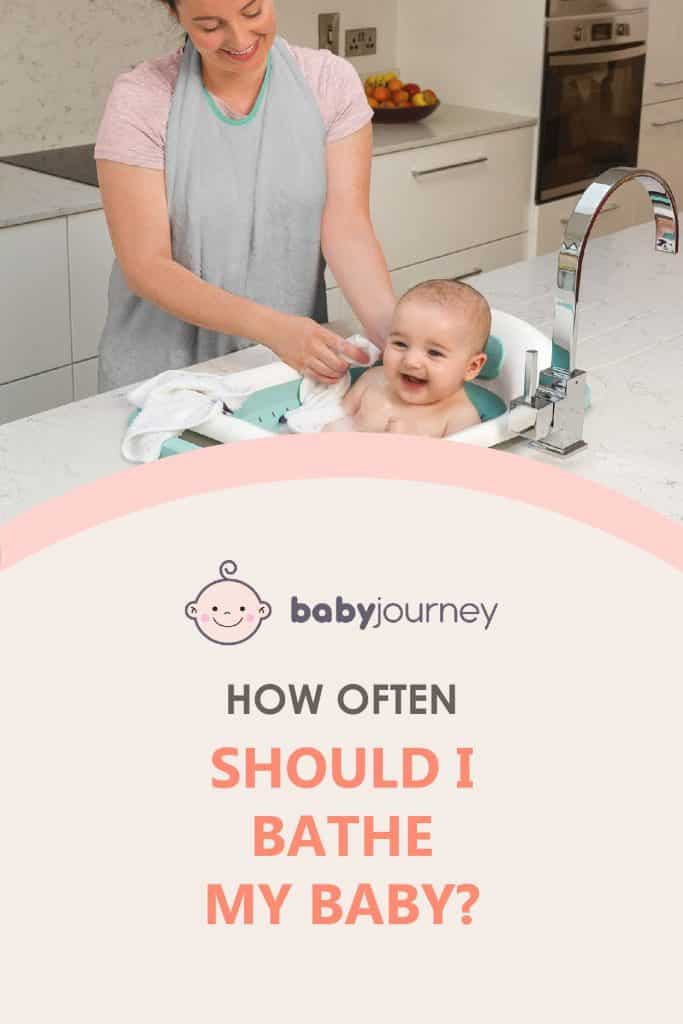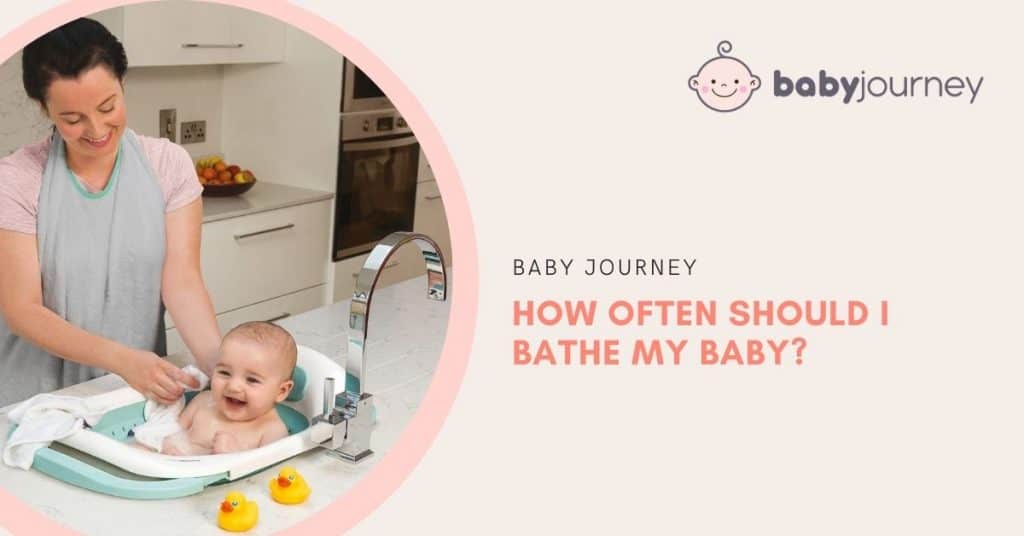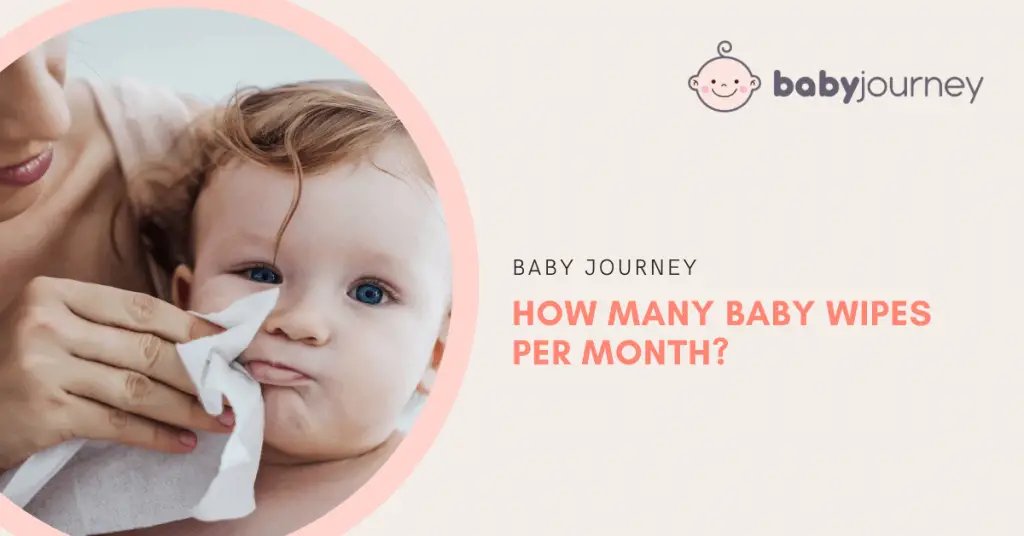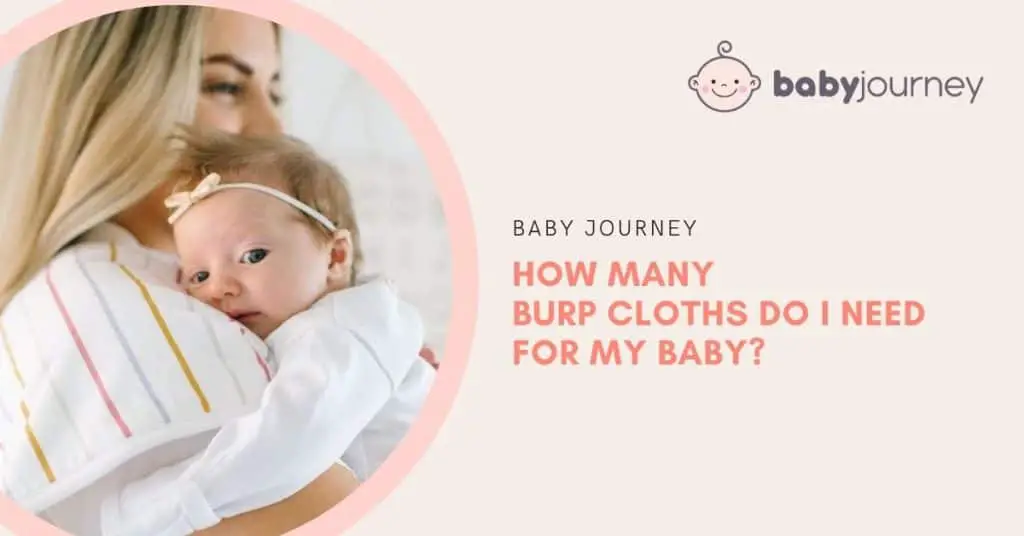Bathing a newborn raises so many questions about frequency, bathing process, water temperature, products, and you are always left wondering if you are doing a good job. Newborns look so fragile that plenty of parents worry if their baby is comfortable during the bath.
Even if you have raised children before, bathing a newborn is always a challenging and stressful experience. This article will guide you through the process and help you answer the first and most important question – How often should I bathe my baby?
Keep reading for more tips on making bathing your baby more comfortable for you and your baby.
How often does a baby need a bath?
It’s no hidden fact that parenting is challenging from the first moment your child is born, and that includes bathing your little one. Many studies focus on the benefits of bathing for newborns, but the science and the parenting community often disagree about when the time is for the first bath.
Let’s go through how bathing frequency changes as the baby grows, from how often does a newborn need a bath up to 12 months old.
Newborn
In the past, it was common to bathe the baby right after the delivery. However, some respected studies showed that newborns might experience some benefits when the first bath is 12 or 48 hours after delivery, such as an increase in breastfeeding. You can find more scientific proof on the effects of bathing on newborns here.
Usually, the first bath of your baby is something the nurses will be in charge of, and it is a great idea to ask them for any tips for home baths. The chances are that they will have a lot to share with you!
Once you and the baby get home, you can bathe the baby two times per week. How often do you bathe a newborn, and how you do it depends on the umbilical stump.
Until the umbilical stump falls off, you shouldn’t submerge the whole baby body in the water. It is better to clean the baby with a wet, soft cloth or a sponge.
Moreover, if the baby spits the milk, you can always use a wet cloth to clean it and change your newborn’s clothes. Pay attention to the neck area as dirt can collect there. Fingers, behind the ears, armpits are also areas where you need to pay special attention.
Still, if the baby poops itself, you can wash it briefly under the umbilical stump. Use mild water for newborns, and light, moisturizing soap if you have to.
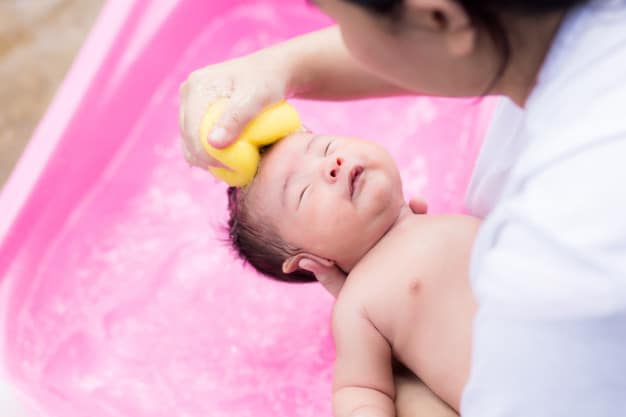
1 – 3 months
As the baby grows, you can keep the two times per week bathing schedule until the third month. You can slowly introduce traditional baths when the belly button heals.
Fill the sink with lukewarm water, and slowly submerge the baby in the water. Try to make the bathing more fun for the baby, splash the water slowly, talk, and sing to the baby. Use gentle baby soap and make the bath short by starting with the head and gently washing the rest of the baby’s body.
You can also wash the baby with you in the shower. But, you might need help to take the baby out of the tub and wrap the baby into the towel to keep it warm.

3 – 6 months old
Generally, when you start introducing basic solid food to the baby from the fourth month, you can wash the baby more frequently. Still, you can combine traditional baths with sponge baths and wash the diaper area more frequently.
You can wipe the baby clean when you are changing the diapers or clothes and keep the two times per week traditional baths schedule.
By now, you would probably know if your baby enjoys baths or not. A warm bath before bedtime can help the baby to calm and have a better sleep.
6 – 12 months old
When your baby starts sitting, crawling, and getting on its feet, bathing will become easier. You can start bathing the baby every other day and make the baths more fun. Have the baby sit in the lukewarm water and play with rubber ducks and bath toys in the sink or tub. Generally, babies love water, but you need to keep them engaged.
Besides, the diaper area will probably need more attention, so you can confidently wash the after-poops.
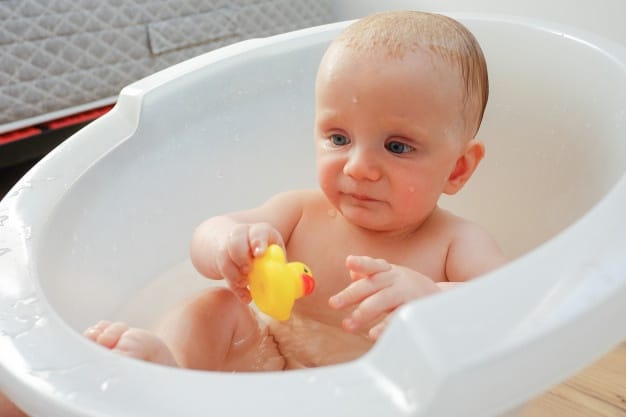
Why shouldn’t I bathe my baby every day?
There is no need to bathe the baby every day because the baby doesn’t get dirty much. Babies do not sweat, and they are usually wearing soft and clean clothes that cover most parts of their body, so the dirt doesn’t accumulate like adults do.
Their skin is sensitive, so you need to be super careful about the use of products, water temperature, and excessive water. Also, too much exposure to warm water can dry the gentle baby skin and aggravate some skin conditions, such as eczema.
You can wash the baby’s face, neck, and fingers every day at every age though.
Extra Tips on Bathing Your Baby
Let’s go briefly through some tips that can make bathing time more enjoyable for your baby.
Tip #1: Prepare the things you need for baby bath beforehand
Prepare all you need before the bath. You will need cotton balls, washcloths, baby wipes, a basin with lukewarm water if you are doing a soap bath, a tiny amount of soap, diapers, and clean cloth.
Tip #2: Sponge bath is the easiest and safest way
The sponge bath is the safest way to keep the baby clean without taking it to the tub or sink. The easiest way to do it is to put the baby on a warm towel and prepare a bowl of lukewarm water. Use one hand to support the baby’s neck, and the other to submerge the sponge in the water and drain it. Then, gently go over the baby to clean it.
You can use cotton balls to clean the eyes, and warm cloth for the hair, if the baby has little hair.
Avoid shampoo and soap for the head, but you can use a tiny amount of mild, baby soap for the body. Rinse the baby briefly and dry it with a soft towel.
Here’s a simple way to perform a sponge bath on your baby:
Tip #3: Use smaller tub or sink for a tub bath
To make the tub bath easier for both the baby and you, use a smaller tub or sink. That way, the baby will feel more secure.
If you have all you need within a hand reach, you will complete the bath sooner.
While the baby is in the sink, always support it with one hand to prevent accidental tips. You can ask someone to help you in the beginning until bathing becomes more comfortable for you.
Tip #4: Two inches of water is enough for a tub bath
How much water is needed for your baby’s bath? If you are doing a tub or sink bath, you don’t need to fill it with more than two inches of water. When the baby starts sitting in the sink or tub, you can use a scoop to pour water on the baby’s shoulders to keep it warm all the time.
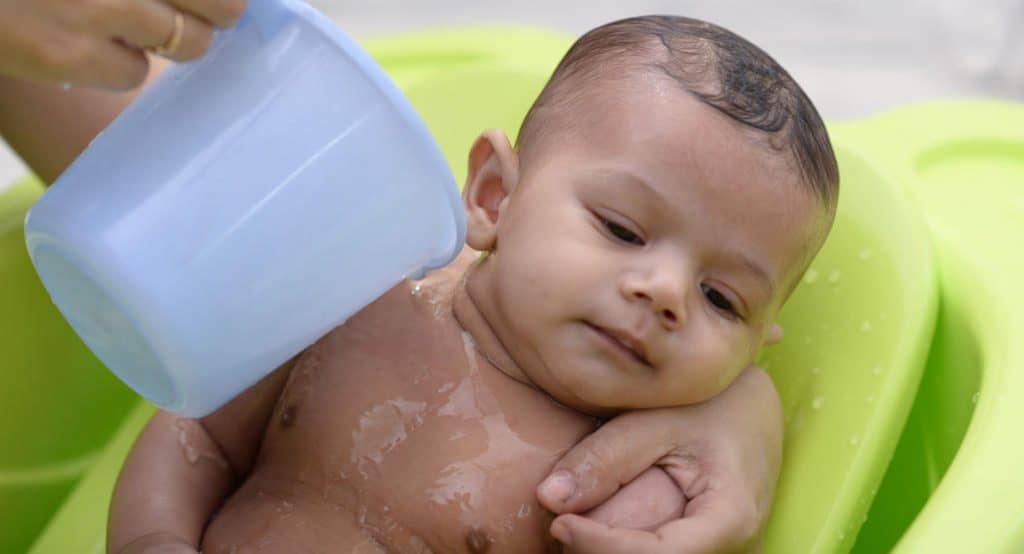
Tip #5: Test for lukewarm water with your elbow or thermometer
You may wonder about the appropriate water temperature for a baby bath. As I mentioned before, babies don’t like too much warm water, and isn’t good for their skin.
The temperature for the baby bath should be just above 100 degrees Fahrenheit (between 37 to 38 degrees Celsius). It is the optimal temperature that will make the baby feel comfortable.
If you don’t have a thermometer, you can test the water with your elbow. The feeling should be lukewarm and pleasant, but not too warm. You can learn more about the appropriate water temperature for babies and how to check it without a thermometer here.
Tip #6: Use only mild, unscented soap
Use only mild soaps that don’t have artificial fragrances. Avoid products with chemicals such as sulfates, phthalates, and parabens. However, even if you buy products specifically created for babies, check the product declaration to ensure it doesn’t contain harsh chemicals.
Tip #7: Wash baby’s hair once a week or once in ten days
Babies don’t like their hair washed. Luckily, even if your baby is born with lots of hair, you don’t have to wash it often – once a week or every ten days is actually enough. You can wash the hair separately from the body.
So how to wash a baby’s hair? Well, once the baby is dry and warm in clean clothes, you can put a tiny amount of shampoo on the hair and massage it gently. Check the water temperature with your elbow, ensuring that it isn’t too hot and briefly rinse only the hair under the faucet.
You will tilt the baby to rinse the hair, but you also need to protect the eyes from potential shampoo drops coming into baby’s eyes.
Watch the video on washing newborn hair below:
P.S. Cuteness overload!
Baby Bathing FAQs
Let’s answer some of the most common questions parents have about bathing their baby.
Is it okay to bathe my baby once a week?
Bathing a baby once a week might not be enough. Too much bathing dries the baby’s skin, but insufficient bathing can lead to infections. Bathing a baby two times per week is an optimal schedule that keeps the skin moisturized and the baby clean.
Should I bathe my baby at night or in the morning?
It depends on you. Some parents like to bathe the baby in the evening as part of the nighttime routine because it helps the baby sleep better. Other parents find their baby won’t fall asleep that easily after a bath. Therefore, see what feels better for the baby.
What happens if you don’t bathe a baby?
The dirt can collect in the belly button, under the neck and arms. Diaper rash and skin rash is also common if you don’t bathe the baby. Still, soap and water are the best way to fight germs. So, if you don’t bathe the baby, you risk infections.
Can I bathe my baby with just water?
It is safe to bath the baby with just water. It will keep the skin moist, and you don’t have to worry about allergies and reactions to chemicals in baby bathing products. However, you can use soap occasionally to clean the diaper area or for hair.
One study focused on finding out the differences between soap and water-only baths for newborns. Still, the results showed that there were no differences in bacteria colonies. However, it is up to you to decide which method to use.
At what age can you use soap on babies?
When the baby has four weeks, you can slowly start using tiny amounts of unscented soap for bathing. Use a small amount to prevent skin reactions. You can also begin using baby shampoo at the same time.
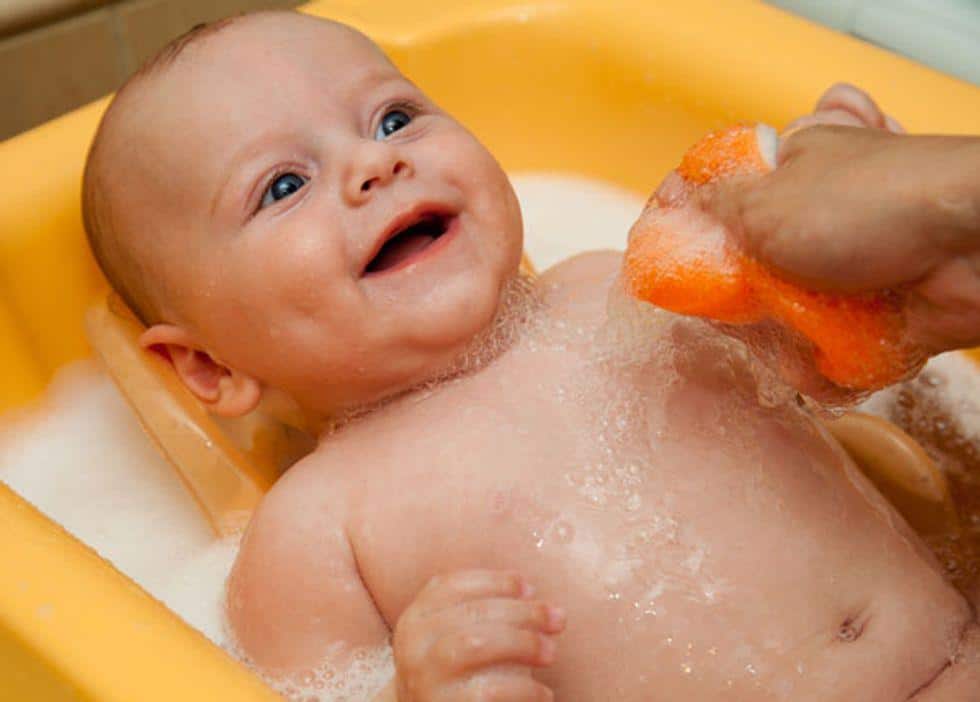
Conclusion
Bathing a newborn is challenging, but with a few tips, bathing can become a lovable activity for you and your child. How many times to bathe a baby depends on the baby’s age. For example, newborns are best to bathe two times per week, and as the baby grows, you can bathe your child more frequently.
Start with a sponge bath and mild soaps, and when the baby starts sitting you can start washing in the sink or tub. And don’t worry if it feels like you are doing something wrong, every parent feels that way at the beginning of the parenting era!
Hope this guide cleared your doubt on “how often should I bathe my baby?”! Do you have more questions about bathing babies? Feel free to ask them in the comments section!
—
